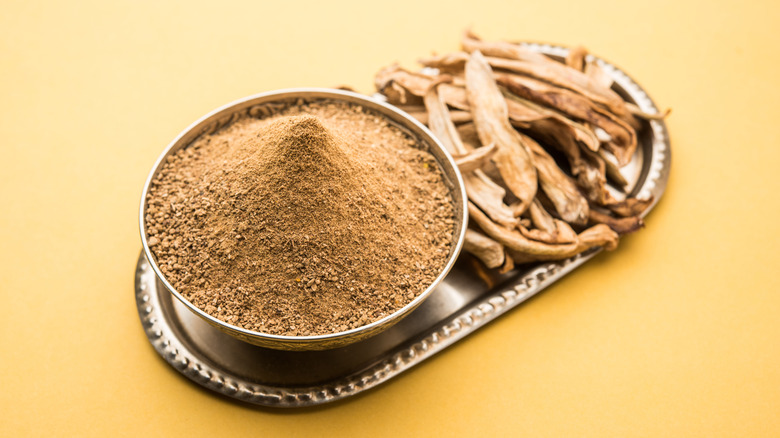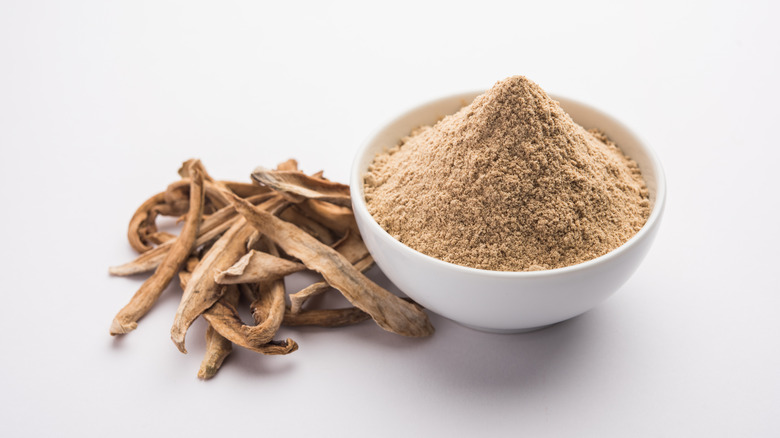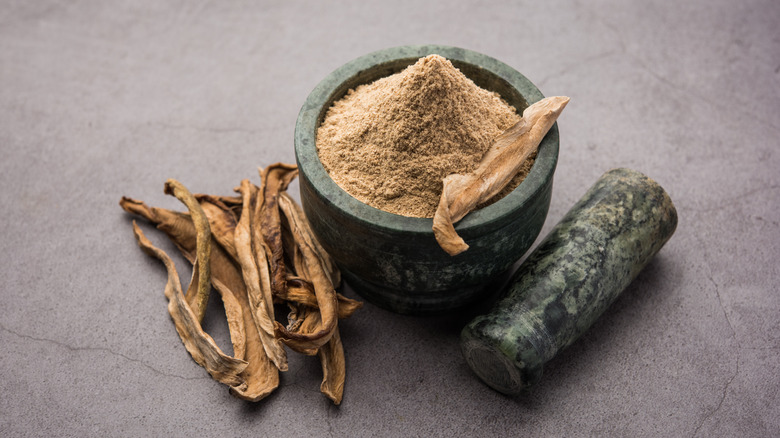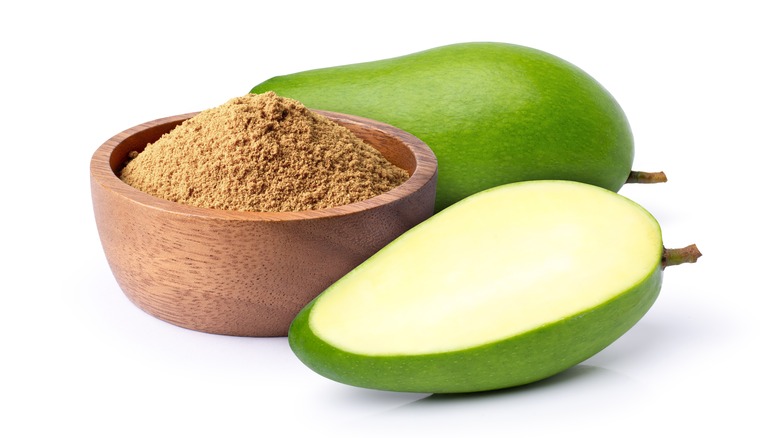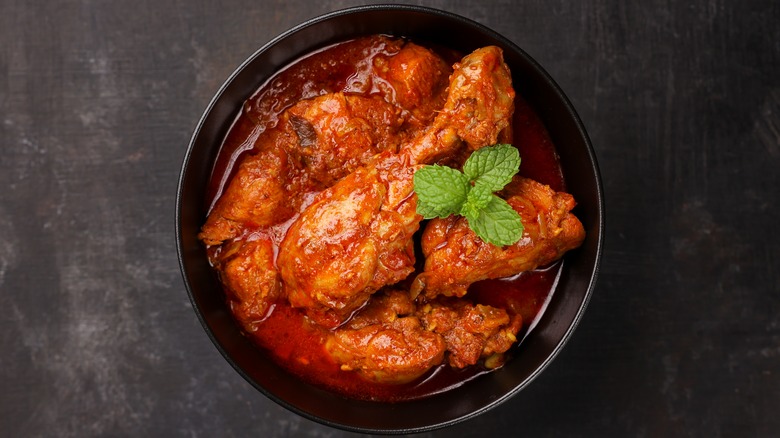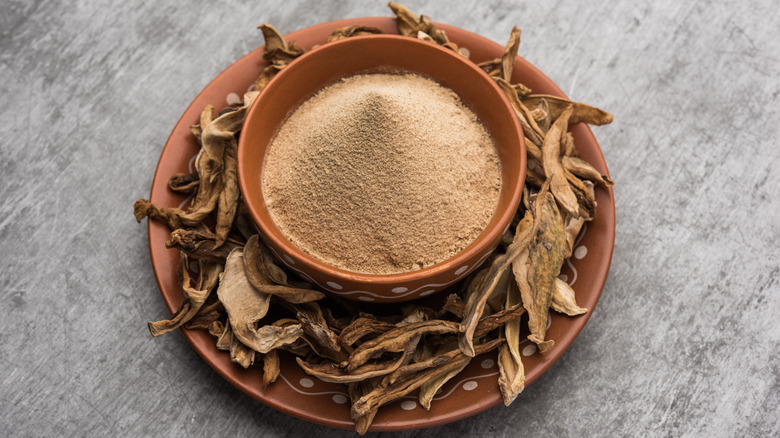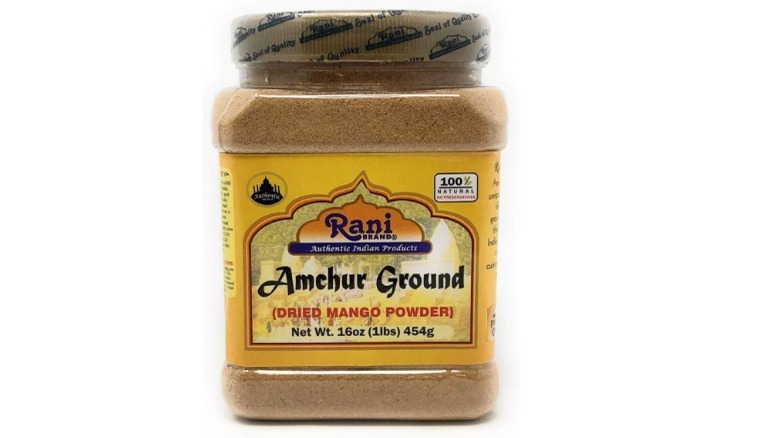Amchur Powder, The Ground Mango Seasoning For Rich Meat Dishes
India is a deeply diverse nation with over 700 ethnic groups, hundreds of languages spoken, and several major faiths practiced. These factors, among others, have influenced the differences between India's regional cuisines. Most people living in the U.S. are likely most familiar with Northern Indian dishes, as these recipes often feature popular ingredients like chicken, lamb, curry, and a variety of mild spices. A few of the crucial North Indian spices include turmeric, cumin, tamarind, and amchur powder.
A tangy seasoning made from dried green mango, amchur powder can be found in samosas, pickles, and chutney as well as sprinkled over grilled meats and veggies. Though it may not be something that's carried at your local grocery store, it can be easily found in specialty shops and online. And be assured, if you don't own a bottle of the flavorful powder already, this seasoning is a must-add to your spice rack.
What is amchur powder?
Amchur powder is a finely-ground powder that is light brown or sand-colored in appearance, similar to cumin. You'll recognize this seasoning by its distinctly sour yet sweet aroma. The word amchur can even be broken down into the two Hindi words "am" and "chur." Respectively, they translate to "mango powder."
For generations, this powder has been an essential ingredient across North Indian cooking, specifically in Punjabi cuisine. While other parts of India would opt for lemon juice or other acidic ingredients to add tartness, this region reaches for this tangy mango powder.
In the hot and humid northern region, mango trees are plentiful and the fruit is frequently enjoyed in several ways in this regional cuisine. However, when making this powder, it is the unripe, green mangoes that are desired, which are peeled, cut, and dried before being turned into this fragrant seasoning.
How is amchur powder made?
No matter where you are located in the world, if you have access to unripe green mangoes, you'll be able to make your very own amchur powder at home. The first step requires sourcing or producing dried mango chips. The thin, raw mango slices are often laid out under the sun for a few days, where they will become withered and fragile. However, in a pinch, the mango can also be dehydrated in a hot oven. The mango should be extremely crisp before being tossed into a grinder, not leathery or tough — the latter qualities signify the slices are not yet dry enough.
Once the slices are completely dried out, they're ground into a very fine-grained powder with a spice grinder or similar appliance. The final result will release a sweet yet acidic tropical scent, and it can remain on your pantry's spice shelf for several months. Soon, it will be your go-to spice to pull out when making your favorite curries and chutneys, thanks to its layered taste.
What does amchur powder taste like?
Even if you're the biggest fan of juicy mangos, you may be a bit apprehensive about trying a spice made from the unripe, sour version of the fruit. While it's true that the powder does undoubtedly have a tart, citrus-like taste that will slightly pucker your lips, there is also a sweet flavor inherent in the powder that some compare to honey. This seasoning balances both the strongly sweet and intensely tangy flavors present in the mango and it is capable of adding the perfect acidic punch to all kinds of Indian dishes.
Amchur powder is often used to add depth to dishes, instead of certain liquids that add similar flavor notes, such as citrus juice or vinegar. It's very versatile to cook with, and this seasoning can be found sprinkled in dishes from chunky samosa fillings to delicately garnishing a cup of after-dinner yogurt.
How to cook with amchur powder
Amchur powder is often added to dishes to balance out sweetness or add a bit of a bite, but the addition of this powder also adds a layer of complexity to whatever it seasons. Many savory dishes, like samosas and kebabs, benefit from the fun dynamic of a sour flavor. Soups, marinades, batters, chutneys, and more will also often feature amchur powder. And, Punjabi curry dishes like chana masala and bhindi masala are arguably not complete without a hefty helping of this spice.
However, it's not just salty and spicy meals that benefit from this added complexity. Sugary desserts, like a yogurt-based treat, or certain breakfast dishes can also feature this spice mixed in or as a garnish. But, perhaps the most famous dish that features this ingredient is jal jeera, a popular summer drink that features mint, coriander, lemon juice, ginger, and more.
Whatever dish is being made, amchur powder is usually poured in toward the end of the cooking process – this way the flavor is stronger and more distinct. If you don't yet currently have this seasoning on your spice rack, and you don't plan on making it yourself, there are a few ways you can still get your hands on it.
Amchur powder nutritional information
There are several perceived health benefits of sprinkling a healthy dose of amchur powder into your favorite dishes. This seasoning is rich in antioxidants, according to Indian online pharmacy Netmeds, which are known to help improve digestion, aid heart health, support healthy vision, and more. Amchur powder is also full of essential vitamins and minerals, including being packed with vitamins A and C, which boost immunity alongside other health benefits. Abundant fiber, calcium, and iron are also present.
Aside from being enjoyed through food, it is also thought to have positive effects when applied to the skin. The pharmacy suggests using it as a facial scrub can help combat acne and promote smooth, blemish-free skin. It is also commonly found in Ayurvedic medicines (traditional and natural medicinal practices native to India) that treat heartburn and some more serious ailments.
Where to buy amchur powder
Amchur powder is quite easy to make on your own, and it often tastes slightly better than a store-bought version. However, there are still plenty of places you can go to purchase a good-sized bag or jar of this seasoning for yourself. And, you should be able to obtain it no matter where you live in the world.
If you want to purchase this seasoning instantly, you will likely have to make a visit to your local South Asian grocery. However, if you're not located in a city, you might find you don't have one near you and will likely have to order online. Fortunately, a few big box stores sell it online, like Walmart and Target, along with Amazon and other online retailers. A quick Google search will yield abundant results, and a regular-sized bottle should be able to be purchased for around $10.
